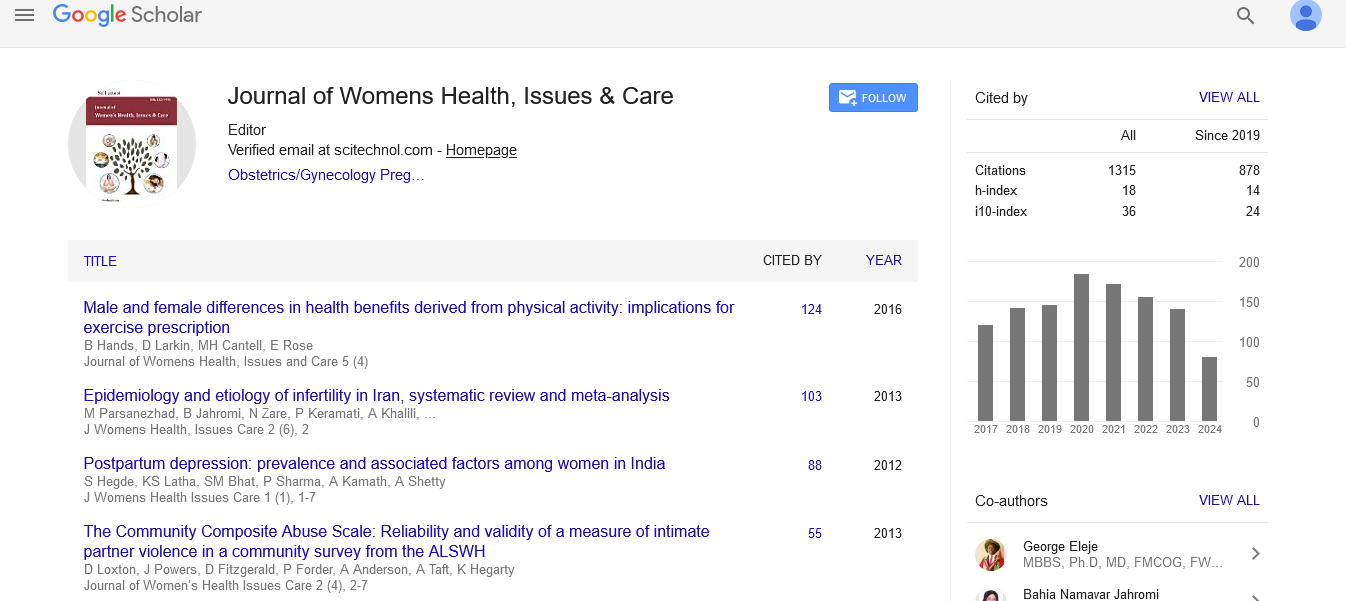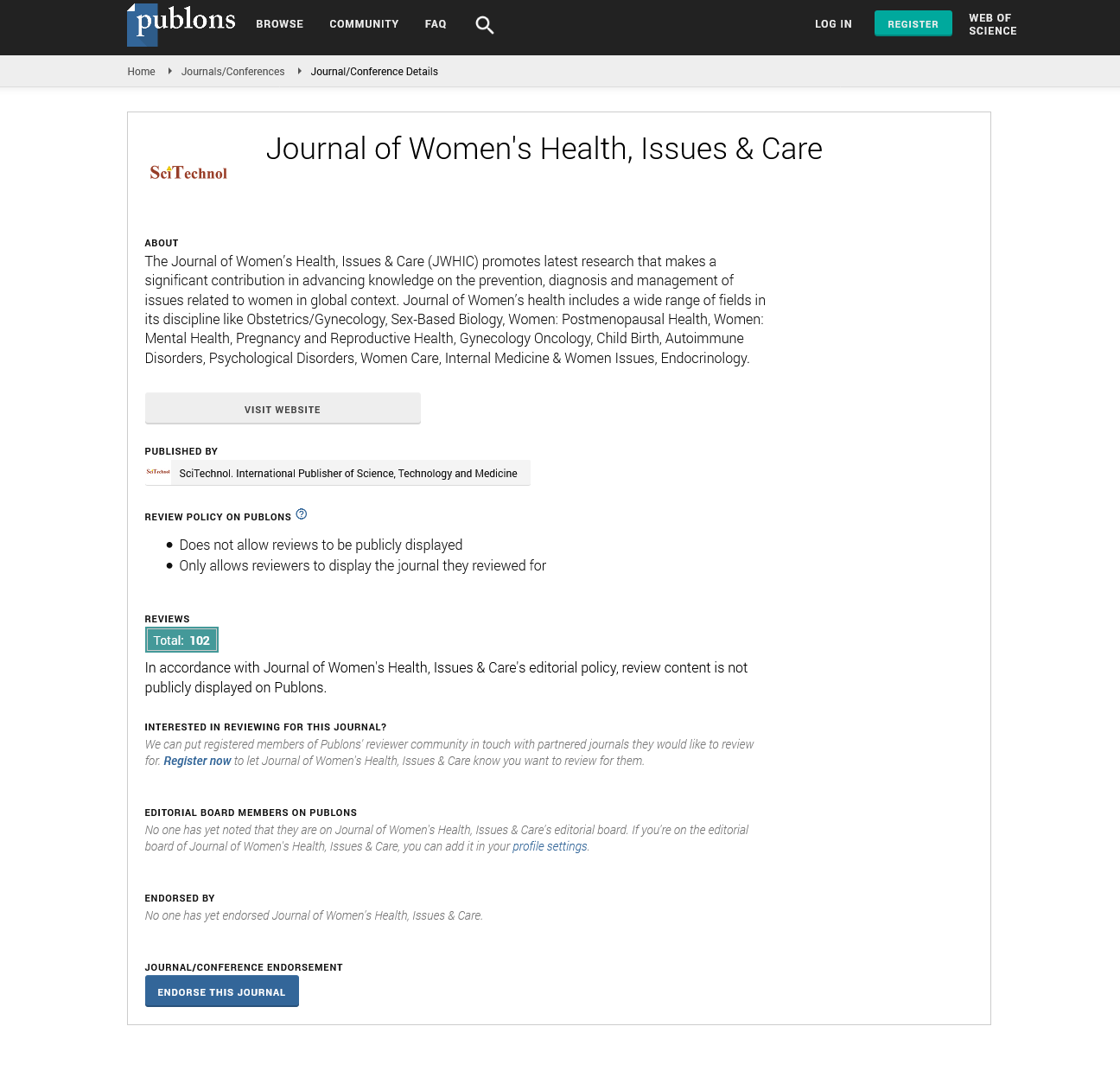Commentary, J Womens Health Vol: 13 Issue: 2
Risk Factors and Resilience: Navigating Women's Vulnerability to Insomnia and Sleep Disorders
Simon Richardson*
1Department of Health and Exercise Science, Wake Forest University, Winston- Salem, North Carolina, USA
*Corresponding Author: Simon Richardson,
Department of Health and Exercise
Science, Wake Forest University, Winston-Salem, North Carolina, USA
E-mail: Richardson.simon@uni.edu
Received date: 27 March, 2024, Manuscript No. JWHIC-24-132532;
Editor assigned date: 29 March, 2024, PreQC No. JWHIC-24-132532 (PQ);
Reviewed date: 12 April, 2024, QC No. JWHIC-24-132532;
Revised date: 19 April, 2024, Manuscript No. JWHIC-24-132532 (R);
Published date: 29 April, 2024 DOI: 10.4172/2325-9795.1000492.
Citation: Richardson S (2024) Risk Factors and Resilience: Navigating Women's Vulnerability to Insomnia and Sleep Disorders. J Womens Health 13:2.
Description
Insomnia and sleep disorders represent a significant public health concern, affecting millions of individuals worldwide. Women are particularly vulnerable to these conditions due to hormonal fluctuations, reproductive factors, and socio-cultural stressors that influence sleep patterns. Despite their impact on health and wellbeing, insomnia and sleep disorders in women are often under recognized and undertreated.
Epidemiology of insomnia and sleep disorders in women
Insomnia, characterized by difficulty falling asleep, staying asleep, or waking up too early, is the most common sleep disorder among women. Epidemiological studies indicate that women are more likely than men to experience insomnia across all age groups. Additionally, women are disproportionately affected by certain sleep disorders such as restless legs syndrome and insomnia disorder. Sleep disturbances are particularly prevalent during key life stages such as pregnancy, postpartum, and menopause, highlighting the influence of hormonal fluctuations on sleep architecture and quality.
Clinical presentation of insomnia and sleep disorders
Insomnia and sleep disorders manifest in a variety of ways, ranging from difficulty initiating or maintaining sleep to excessive daytime sleepiness and impaired cognitive function. Women may experience additional symptoms such as mood disturbances, fatigue, and decreased quality of life, further exacerbating the impact of sleep disturbances on overall well-being. The clinical presentation of insomnia and sleep disorders in women is influenced by a myriad of factors, including hormonal fluctuations, reproductive events, coexisting medical conditions, and psychosocial stressors.
Risk factors for insomnia and sleep disorders in women
Several risk factors contribute to the development of insomnia and sleep disorders in women, including biological, psychological, and socio-cultural factors. Hormonal fluctuations associated with menstrual cycles, pregnancy, and menopause can disrupt sleep patterns and contribute to insomnia symptoms. Psychosocial stressors such as work-related stress, caregiving responsibilities, and socio-economic disparities also increase the risk of sleep disturbances in women. Additionally, coexisting medical conditions such as depression, anxiety, and chronic pain syndromes are commonly associated with insomnia and sleep disorders in women.
Management strategies for insomnia and sleep disorders
The management of insomnia and sleep disorders in women requires a multidisciplinary approach that addresses underlying causes and targets symptom relief. Non-pharmacological interventions such as Cognitive-Behavioral Therapy for Insomnia (CBT-I), sleep hygiene education, and relaxation techniques are often recommended as firstline treatments for insomnia. Pharmacological interventions, including sedative-hypnotic medications and melatonin agonists, may be considered for short-term management of insomnia symptoms. In addition to symptom-focused interventions, addressing underlying comorbidities and optimizing overall health is essential for long-term management of sleep disturbances in women.
Conclusion
Insomnia and sleep disorders are prevalent conditions that significantly impact the health and well-being of women across the lifespan. Despite their high prevalence, these conditions are often under recognized and undertreated, leading to chronic sleep deprivation and its associated consequences. By enhancing understanding of the epidemiology, clinical presentation, risk factors, and management strategies for insomnia and sleep disorders in women, healthcare providers can improve diagnosis, treatment, and ultimately, the quality of life for women affected by sleep disturbances. Further research is needed to elucidate the underlying mechanisms of sleep disturbances in women and develop targeted interventions to address their unique needs.
 Spanish
Spanish  Chinese
Chinese  Russian
Russian  German
German  French
French  Japanese
Japanese  Portuguese
Portuguese  Hindi
Hindi 



